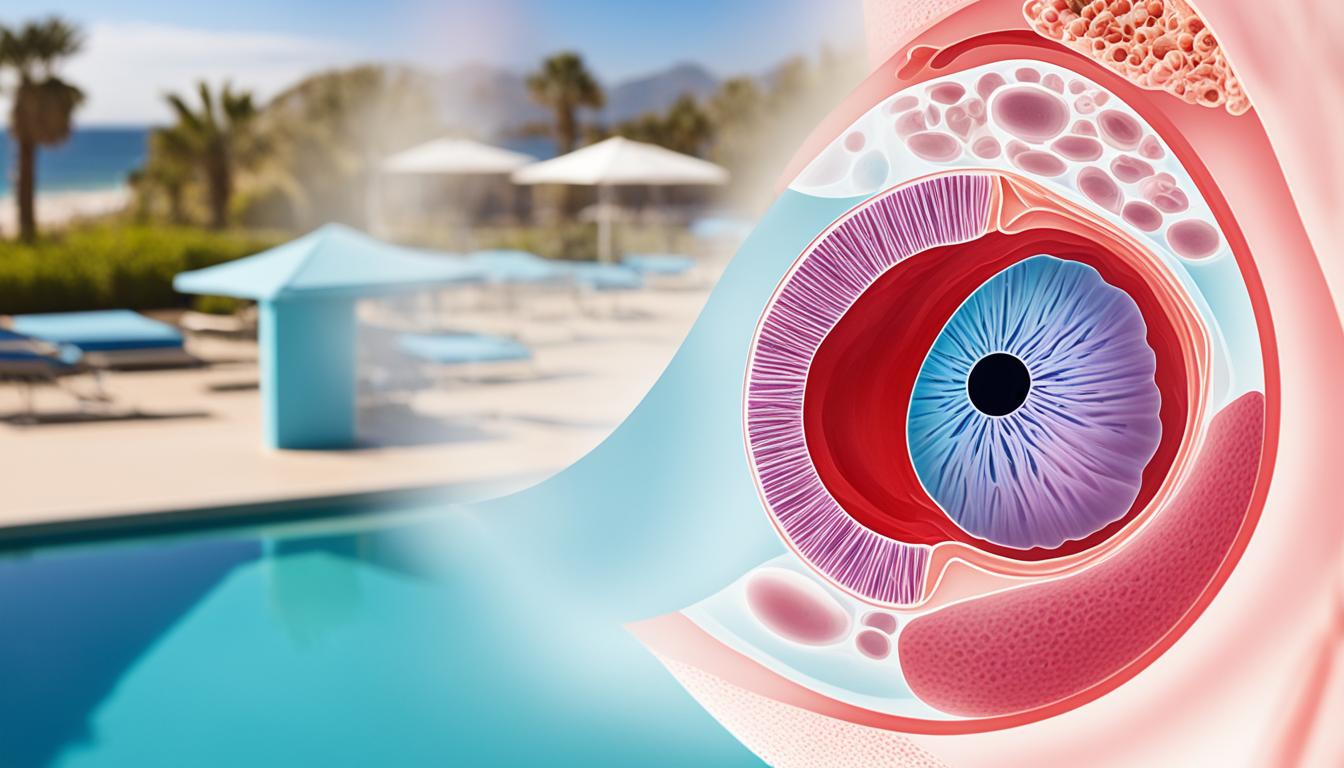Swimmer’s ear disease is an infection of the outer ear canal. It brings discomfort and pain. People who swim often or do water sports get it. The main cause is water staying in the ear, allowing bacteria to grow. It can also happen due to too much earwax, skin issues, having diabetes, or using hearing aids.
The symptoms of swimmer’s ear are itchiness, fullness in the ear, pain, and discharge. It’s key to spot these signs early. This helps avoid complications and more pain. Treatment includes removing earwax, using ear drops, or in bad cases, taking oral antibiotics.
Stem cell therapy is a new approach for treating swimmer’s ear. It uses cells to fix damaged tissues and speed up healing. Although it’s still in the research phase, stem cell therapy has shown good early results for ear problems.
Key Takeaways:
- Swimmer’s ear is an outer ear canal infection that affects frequent swimmers or water sports enthusiasts.
- Infections happen when water stays in the ear, creating a good place for bacteria to grow.
- Extra earwax, skin issues, diabetes, and hearing aids increase the risk of getting swimmer’s ear.
- Aggravating symptoms include itchiness, ear fullness, pain, and discharge.
- To treat swimmer’s ear, doctors may remove earwax, prescribe ear drops, or use antibiotics.
- Stem cell therapy is a novel treatment option that’s showing potential for managing and healing swimmer’s ear.
Causes and Risk Factors of Swimmer’s Ear
Swimmer’s ear, or otitis externa, often happens when water stays in the ear. This makes a damp place where bacteria can grow. Swimming, taking baths, and water sports can lead to this.
Too much earwax can also aid bacteria growth by trapping moisture. Cleaning the ears well helps control earwax. This is a good way of avoiding swimmer’s ear.
People with skin eczema have a higher risk. Eczema can make ear skin more sensitive and open to infection. Thus, they are more likely to get swimmer’s ear.
Diabetes and wearing hearing aids increase the chance of getting this infection too. Diabetes affects ear protection against germs. Similarly, hearing aids can block moisture from moving out of the ear, encouraging bacteria.
To keep swimmer’s ear away, wearing earplugs or a swim cap is a smart move. After being in water, make sure to dry your ears completely. And be careful not to put things in your ears, as these can hurt the skin and disturb its natural defenses.
Risk Factors for Swimmer’s Ear:
- Water getting trapped in the ear canal
- Excessive earwax
- Skin eczema
- Diabetes
- Hearing aids
It’s key to know what causes and worsens swimmer’s ear to act against it. Good habits in ear care and watching for ways water enters the ear can greatly cut chances of having swimmer’s ear.
Symptoms and Diagnosis of Swimmer’s Ear
Swimmer’s ear, or otitis externa, shows key signs that help with diagnosis. At first, it feels itchy in the ear, then it feels full, like something’s blocking it. As it gets worse, the pain increases, especially when you touch or lay on it. It can also cause the ear to swell and release discharge.
A doctor will check the ear carefully to diagnose swimmer’s ear. This involves looking for redness, swelling, and any discharge. Finding these signs means there’s an infection. The doctor might also ask about your symptoms and medical history to understand more.
Sometimes, a test may be needed to see which bacteria is causing the infection. A culture of the ear discharge will show which bacteria is there. Knowing this helps choose the right treatment. It shows which antibiotics will work best.
Summary:
Swimmer’s ear brings symptoms like itchiness, ear fullness, pain, swelling, and discharge. These get worse as the infection spreads. A doctor can diagnose it by checking for certain signs. They might do extra tests, like an ear discharge culture, to find the exact bacteria.
Stem Cell Therapy for Swimmer’s Ear and Conclusion
Conventional treatments for swimmer’s ear often work well. These include ear drops and antibiotics. Scientists are now looking into new ways to treat it, like stem cell therapy. Stem cell therapy uses the power of cells to repair damage and aid the healing process.
Initial studies on stem cell therapy for ear issues show good signs. This includes for swimmer’s ear. It works by adding healthy stem cells to the damaged part. This helps the body heal better and reduces symptoms. Still, we need more studies to know all the ways this can help and its limits.
In sum, swimmer’s ear is both common and unpleasant. Good treatment means spotting the signs, getting the right medical help, and thinking about new therapies like stem cell treatment. Thanks to progress in medicine and the search for new ways to treat it, there’s hope for easing the symptoms and cutting down on the problems this issue can bring.

